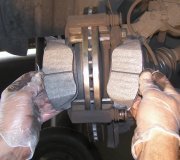Please allow me to add to this repair. I've been involved with three brake fluid contaminated cars. Two with transmission fluid and one with power steering fluid.
Any time the brake fluid is contaminated with a petroleum product, every part that contains a rubber part that contacts the brake fluid must be removed, the steel lines must be flushed and dried, then all new parts installed. That includes the wheel cylinders, calipers, rubber flex hoses, master cylinder and reservoir cap, combination valve, and rear height-sensing proportioning valve when used, (mainly on pickup trucks and minivans).
The dandy clue here is the rubber bladder seal under the reservoir cap is blown up and mushy from not being compatible with petroleum-based products. That also includes penetrating oil, wheel bearing grease, and engine oil. The rubber lip seals on the pistons inside the master cylinder have grown the same way. They've grown large enough to block the fluid return ports in the master cylinder. That is what's keeping the fluid trapped and under pressure. That keeps the calipers applied enough to cause brake drag, then the heat that's generated migrates into the brake fluid causing it to expand. Since it can't flow back up into the reservoir, it applies the calipers even harder, and even more heat is generated.
You can verify this by stopping on a slight incline, shifting to "neutral", releasing the brake pedal, and you'll see the truck doesn't creep downhill on its own. Next, since we already know the restriction is in the master cylinder, place a block about a foot downhill of one tire, then use a line wrench, (aka "flare-nut wrench), to loosen the soft metal line nuts right at the master cylinder. A half turn should be enough. That will let the pressure release. The brakes will release, and the truck will start to move on its own.
The only time I would risk replacing just the master cylinder is if I knew for sure the petroleum product had been dumped into the reservoir within the last few hours and the vehicle wasn't driven since then. For all other cases, if any rubber part is not replaced, the contamination is going to leach out of it and recontaminate the new brake fluid.
The fluid can also be contaminated by using penetrating oil to try to separate metal parts such as steel lines from rubber flex hoses. Professionals even wash their hands with soap and water before touching these rubber parts to avoid getting fingerprint oil on them.
Obviously, this gets to be a very expensive repair, often more than an older car is worth. If the vehicle has anti-lock brakes, the hydraulic controller must be replaced too since it contains rubber o-rings.
Saturday, October 9th, 2021 AT 5:33 PM








